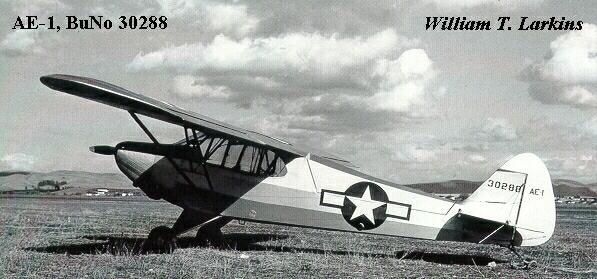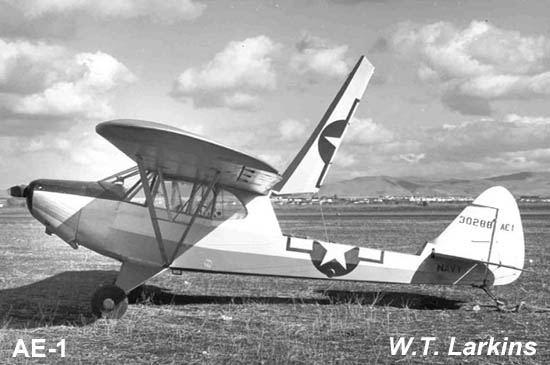

When people think of evacuating wounded or injured personnel today, the image of a helicopter hovering or landing in a clearing pops into the mind. However, in 1942 there were no helicopters in the U.S. Navy (USN) inventory; it would be another 1-1/2 years before one was acquired and then substantial testing to develop recovery techniques. To provide aerial ambulances, the USN used a number of converted civilian aircraft to carry one or more casualties. One of these aircraft was the Model J-5C Cub Cruiser built by the Piper Aircraft Corporation of Lock Haven, Pennsylvania.
The Piper J-5 Cub Cruiser was a single-engine high-wing monoplane with fixed landing gear that had been developed from the J3 Cub. (In USN service, the J3 Cub was designated NE, q.v.) All three models of the J-5 were powered by an air-cooled engine with four-horizontally opposed cylinders driving a two-bladed wooden propeller. The J-5 used the same wing, tail surfaces and controls as the J3 but the fuselage was widened to accommodate two passengers in the rear seat rather than one that could be accommodated in the J3. Unlike the J3, the J-5 had a metal cowling surrounding the engine and one additional longeron, the structural member running from front to rear in the fuselage; the rest of the aircraft was constructed of spruce, aluminum-alloy and welded steel-tube framework all covered with fabric.
The first model, introduced in January 1940, was the J-5A equipped with a 75 hp (55.9 kW) Continental A-75-8 engine; later J-5As had an 80 hp (59.7 kW) Continental A-80 engine. The second model, also introduced in 1940, was the J-5B equipped with a 75 hp (55.9 kW) Lycoming engine. The last model, introduced in early 1942 before civilian production was terminated, was the J-5C powered by a 100 hp (74.6 kW) Lycoming O-235 engine. The J-5C had a one-piece windshield in the last few units, aluminum spars in place of spruce spars and a rubber shock mounted landing gear. A total of over 1,405 Model J-5s, including 35 J-5Cs, were produced.
 One hundred modified J-5Cs
were ordered by the USN as HE-1 ambulance aircraft in 1942. These aircraft
could accommodate a pilot and one stretcher. The deck of the fuselage from
the trailing-edge of the wing to the vertical fin was arranged to hinge
up to permit the loading and unloading of one USN standard litter. The
hinge was located forward at the rear of the wing.
One hundred modified J-5Cs
were ordered by the USN as HE-1 ambulance aircraft in 1942. These aircraft
could accommodate a pilot and one stretcher. The deck of the fuselage from
the trailing-edge of the wing to the vertical fin was arranged to hinge
up to permit the loading and unloading of one USN standard litter. The
hinge was located forward at the rear of the wing.
The USN took delivery of their first helicopter in late 1943 and a decision was made to reassign the Type/Class Designation H, indicating Hospital aircraft, to helicopters and establish a new Type/Class Designation of A for Ambulance aircraft. As a result, all HE-1s were redesignated AE-1s in 1943.
OPERATIONAL HISTORY
In USN service, the HE-1/AE-1 aircraft were usually based at small, remote air stations, e.g., Naval Auxiliary Air Stations (NAASs) Brown Field and Holtsville, California; Chase Field, Texas; Martha's Vineyard, Massachusetts; Oceana, Virginia; Vero Beach, Florida, etc. that were located some distance from major medical facilities.
The U.S. Marine Corps (USMC) accepted their first in 1943. By August of that year, the Marines were operating seven aircraft assigned to the Base Air Detachments (BADs) at Marine Corps Air Stations (MCASs) Cherry Point, North Carolina (2); El Centro (1), El Toro (1) and Mojave (1), California; Quantico, Virginia (1); and Parris Island, South Carolina (1).
With the introduction of helicopters, these aircraft became superfluous and all were discarded soon after the war ended.
SPECIFICATIONS
Wing Span: 35 feet 5.5 inches
(10.81 meters)
Length: 22 feet 6 inches
(6.86 meters)
Height: 6 feet 10 inches
(1.85 meters)
Wing Area: 179 square feet
(16.6 square meters)
Empty Weight: 906 pounds
(411 kg)
Gross Weight: 1,426 pounds
(554 kg)
Maximum Speed: 110 mph (177
km/h)
Cruise Speed: 90 mph (145
km/h)
Service Ceiling: 15,000
feet (4,572 meters)
Initial Climb Rate: 600
feet (183 meters) per minute
Range: 264 miles (425 km)
Armament: None